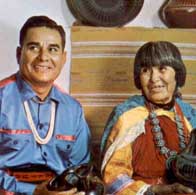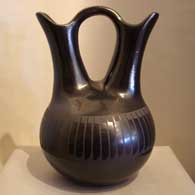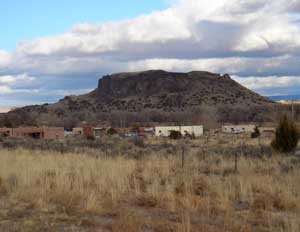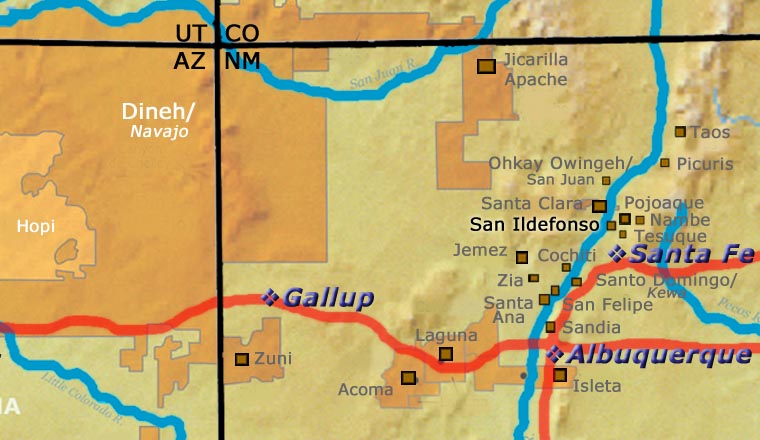
Popovi Da
1922-1971
San Ildefonso


Popovi Da was the youngest son of Julian and Maria Martinez. He was named Antonio Jose Martinez at birth but changed that legally to Popovi Da (Red Fox) in 1948. He grew up learning how to make pottery with his parents while he attended the San Ildefonso school, then Santa Fe Indian School. Among his fellow students at SFIS were Harrison Begay, Quincy Tahoma, Allan Houser, Pablita Velarde and Andy Tsihnahjinnie. It was in their company that he developed really fine technical skills as a painter, jeweler and watercolor artist creating works featuring wildlife, geometric designs and abstract symbolism.
He was drafted by the US Army in 1944 and was stationed at Los Alamos and the Manhattan Project. After he was discharged from the Army, he and his wife, Anita, returned to San Ildefonso and opened the Popovi Da Studio of Indian Arts. The Studio offered works for sale from many San Ildefonso potters and included a museum of some of the finest works by Popovi's mother and by other fine Native American artists. Popovi served as Director of the School of American Research, Chairman of the All-Indian Pueblo Council and served on the board of the New Mexico Arts Commission during those years. He also served six terms as Governor of San Ildefonso Pueblo.
He began painting pottery with Maria and his sister-in-law, Santana Martinez, around 1950. At first Santana would outline the designs and Popovi would fill them in. Then in 1956 Maria enrolled him in painting pots full time for her. He also took over the digging and preparing of clay as his father had done before him and became Maria's sole working partner. At that point Maria changed her signature from Marie to Maria and they signed Maria and Popovi together, and later added a date. It was during those years that he began working to revive the making of polychrome pottery at San Ildefonso after 40 years of producing primarily black-on-black wares. He didn't make a pot alone until 1962. It was after that that he was sometimes too busy with his own pieces, politics and religious affairs of the pueblo to paint for Maria. That was when Maria's signature became Maria Poveka and the pieces were undecorated. However, Popovi's technical decorating skills were so high that his pieces alone and those he made with Maria are among the most valuable and most collectible of all Pueblo pottery.
Popovi was known as the Great Experimenter because he developed the techniques for producing the gunmetal and sienna finishes, both produced by manipulating the firing process. It was Popovi who also is believed to have developed the first turquoise inlay, a technique now employed by maybe 100 different potters in several different tribes. Sgraffito (ie: to scratch) is another technique pioneered at San Ildefonso by Popovi Da as it had never been used before on San Ildefonso pottery.
Popovi began working to revive the San Ildefonso polychrome style in 1956 and entered the first polychrome piece he was happy with in the Gallup Inter-Tribal Ceremonial in 1957. It earned the Best of Class ribbon. In 1967 the Institute of American Indian Arts presented the Three Generations show in Santa Fe, NM, and at the US Department of the Interior in Washington, DC, featuring works by Maria, Popovi and Popovi's son, Tony Da. Since his untimely death in 1971, Popovi's work has been featured in several major exhibitions and shows and some of his pieces are in the permanent collections of several major museums around the world, including the Smithsonian Institution in Washington, DC and the Museum Fur Volkerfunde in Berlin, Germany.
Some Exhibits that Featured Popovi's Work
- A Century of Pueblo Painters: San Ildefonso Pueblo 1900-1999. Adobe Gallery. Santa Fe, New Mexico. March 3, 2017 - April 30, 2017. Group show and sale
- Beauty Speaks For Us. Heard Museum. Phoenix, Arizona. February 10, 2017 - March 31, 2017
- Something Old, Something New, Nothing Borrowed: New Acquisitions from the Heard Museum Collection. Heard Museum. Phoenix, Arizona. April 2, 2011 - March 18, 2012
- Choices and Change: American Indian Artists in the Southwest. Heard Museum North. Scottsdale, AZ. June 2007
- Gifts to Celebrate. Heard Museum. Phoenix, AZ. October 2005 - July 2006
- Home: Native Peoples in the Southwest. Heard Museum. Phoenix, AZ. May 2005
- The Collecting Passions of Dennis and Janis Lyon. Heard Museum. Phoenix, AZ. May 2004 - September 2004
- Masterworks by Native Peoples of the Southwest. Heard Museum. Phoenix, AZ. June 2003
- A Revolution in the Making: The Pottery of Maria and Julian Martinez. Heard Museum. Phoenix, AZ. May 2003 - September 2003
- Jewels of the Southwest. Arizona Historical Society Museum. Tempe, AZ. February 2002 - April 2002
- Images, Artists, Styles: Recent Acquisitions from the Heard Museum Collection. Heard Museum North. Scottsdale, AZ. July 2001 - December 2001
- Recent Acquisitions. Heard Museum. Phoenix, AZ. July 1997 - January 1998
- When the Rainbow Touches Down. Heard Museum. Phoenix, AZ. October 1986
- Native Peoples of the Southwest. Heard Museum. Phoenix, AZ. 1985 - 2003
- Native American Paintings: Selections from the Museum of the American Indian. Heard Museum. Phoenix, AZ. September 1982 - November 1982
- One Thousand Years of Southwestern Indian Ceramic Art. ACA American Indian Arts. New York, NY. December 1981 - 1982
- Fifth Scottsdale National Indian Arts Exhibition. Executive House. Scottsdale, AZ. March 5, 1966 - March 13, 1966
100 West San Francisco Street, Santa Fe, New Mexico 87501
(505) 986-1234 - www.andreafisherpottery.com - All Rights Reserved

San Ildefonso Pueblo
San Ildefonso Pueblo is located about twenty miles northwest of Santa Fe, New Mexico, west of Pojoaque, south of Santa Clara and straddling the Rio Grande. Although their ancestry has been traced to prehistoric pueblos in the Greater Mesa Verde area, the prehistoric pueblo at Tsankawi, in a non-contiguous parcel of Bandelier National Monument, is their most recent ancestral home. Tsankawi abuts the reservation on its northwest side.
Franciscan monks named the village after San Ildefonso and in 1617, forced the tribe to build a mission church on top of the village's main kiva. Before that the village was known as Powhoge, "where the water cuts through" (in Tewa). Today's pueblo was established as long ago as the 1300s. When the Spanish arrived in 1540, they estimated the village population at about 2,000.
That mission was destroyed during the Pueblo Revolt of 1680 and when Don Diego de Vargas returned to reclaim San Ildefonso in 1694, he found virtually all the Tewa people camped out on top of nearby Black Mesa. After an extended siege the two sides negotiated a treaty and the people returned to their villages. However, the next 250 years were not so good for them.
The swine flu pandemic of 1918 reduced the pueblo's population to about 90. Their population has grown to more than 600 since but the only economic activity available on the pueblo itself involves creating art in one form or another. The only other work is off-pueblo. San Ildefonso's population is small compared to neighboring Santa Clara Pueblo, but the pueblo maintains its own religious traditions and ceremonial feast days.
San Ildefonso is most known for being the home of the most famous Pueblo Indian potter, Maria Martinez. Many other excellent potters from this pueblo have produced quality pottery, too, among them: Blue Corn, Tonita and Juan Roybal, Dora Tse Pe and Rose Gonzales. Of course, the descendants of Maria Martinez are still important pillars of San Ildefonso's pottery tradition. Maria's influence reached far and wide, so far and wide that even Juan Quezada of the Mata Ortiz pottery renaissance in Chihuahua, Mexico, came to San Ildefonso to learn from her.
100 West San Francisco Street, Santa Fe, New Mexico 87501
(505) 986-1234 - www.andreafisherpottery.com - All Rights Reserved

Maria Martinez Family Tree
Disclaimer: This "family tree" is a best effort on our part to determine who the potters are in this family and arrange them in a generational order. The general information available is questionable so we have tried to show each of these diagrams to living members of each family to get their input and approval, too. This diagram is subject to change should we get better info.
- Cipriana Peña (c. 1810-)
- Santana Peña (1846-) & Antonio Domingo Peña (1841-)
- Nicolasa Peña Montoya (1863-1904) & Juan Cruz Montoya
- Tonita Martinez Roybal (1892-1945) & Alfredo Montoya
- Isabel Montoya (1898-1996) & Benjamin Atencio
- Angelita Atencio Sanchez (1927-1993) & Santiago Sanchez
- Sandra Sanchez Chaparro
- Gilbert Atencio (1930-1995)
- Tony Atencio (1928-)
- Helen Gutierrez (1935-1993) & Frank Gutierrez (Santa Clara)
- Carol & James Gutierrez
- Kathy Gutierrez Naranjo & Ernest J. Naranjo
- Rose Gutierrez
- Geraldine Gutierrez Shije (1959-)
- Angelita Atencio Sanchez (1927-1993) & Santiago Sanchez
- Rayita Montoya
- Santana Montoya & Antonio Vigil
- Lupita Vigil Martinez (1918-2006) & Anselmo Martinez (1909-1965)
- Reyes Peña (d. 1909) & Tomas Montoya (d. 1914)
- Desideria Montoya (1889-1982)
- Maria Montoya Martinez (1887-1980) & Julian Martinez (1884-1943)
- Adam Martinez (1903-2000) and Santana Roybal Martinez (1909-2002)
- George Martinez (1943-) & Pauline Martinez (Santa Clara)(1950-)
- Adam Martinez
- Jesse Martinez
- Jolene Martinez
- Anita Martinez (d. 1992) & Pino Martinez
- Barbara Tahn-Moo-Whe Gonzales (1947-) & Robert Gonzales
- Aaron Gonzales (1971-)
- Brandon Gonzales (1983-)
- Cavan Gonzales (1970-)
- Derek Gonzales (1986-)
- Kathy Wan Povi Sanchez (1950-) & Gilbert Sanchez
- Corrine Sanchez
- Gilbert Abel Sanchez
- Liana Sanchez
- Wayland Sanchez
- Evelyn Than-Povi Garcia
- Myra Garcia
- Berlinda Garcia
- Myra Garcia
- Peter Pino
- Barbara Tahn-Moo-Whe Gonzales (1947-) & Robert Gonzales
- Viola Martinez/Sunset Cruz & Johnnie Cruz Sr.
- Beverly Martinez (1960-1987)
- Marvin Martinez (1964-) and Frances Martinez
- Marvin Lee Martinez
- Johnnie Cruz Jr. (1975-)
- Juan Diego Martinez (1915-1966) & Clara (Silva) Martinez
- George Martinez (1943-) & Pauline Martinez (Santa Clara)(1950-)
- Popovi Da (1921-1971) & Anita Da
- Tony Da (1940-2008)
- Adam Martinez (1903-2000) and Santana Roybal Martinez (1909-2002)
- Maximiliana Montoya (1885-1955) & Cresencio Martinez (1879-1918)
- Juanita Vigil (1898-1933) & Romando Vigil (1902-1978)
- Carmelita Vigil (1925-1999) & Nicholas Cata
- Martha Appleleaf (1950-)
- Erik Fender (1970-)
- Gloria Maxey (d. 1999)
- Angelina Maxey (1970-)
- Jessie Maxey (1972-)
- Martha Appleleaf (1950-)
- Carmelita Vigil (Dunlap) (1925-1999) & Carlos Dunlap (d. 1971)
- Carlos Sunrise Dunlap (1958-1981)
- Cynthia Star Flower Dunlap (1959-)
- Jeannie Mountain Flower Dunlap (1953-)
- Linda Dunlap (1955-)
- Carmelita Vigil (1925-1999) & Nicholas Cata
- Philomena Peña & Juan Gonzales & Ramona Sanchez (Robert's mother)
- Robert Gonzales & Rose (Cata) Gonzales (San Juan)
- Tse-Pe & Dora Tse-Pe (Zia)
- Candace Tse-Pe
- Gerri Tse-Pe
- Irene Tse-Pe
- Tse-Pe (1940-2000) & Jennifer Tse-Pe (Sisneros) (second wife, San Juan/Santa Clara)
- Tse-Pe & Dora Tse-Pe (Zia)
- Oqwa Pi (Abel Sanchez)(1899-1971) & Tomasena (Cata) Sanchez (1903-1985, Rose Gonzales' sister)
- Skipped generation
- Russell Sanchez (1966-)
- Skipped generation
- Louis Wo-Peen Gonzales & Juanita Wo-Peen Gonzales (1909-1988)
- Adelphia Martinez
- Lorenzo Gonzales (adopted) (1922-1995)
- Blue Corn (Crucita Calabaza - Lorenzo's sister) (1921-1999)
- Robert Gonzales & Rose (Cata) Gonzales (San Juan)
- Nicolasa Peña Montoya (1863-1904) & Juan Cruz Montoya
- Tonita Peña (1847-c. 1910)
- Anastacia Peña (c. 1876-)
- Luisa Peña
- Isabel Peña (c. 1881-) & Pasqual Martinez
- Teracita Martinez
- Petronella Martinez & Emiliano Abeyta (San Juan/Ohkay Owingeh)
- Philopeta Martinez (1925-) & Patrick Torres
- Elvis Torres (1960-)
- Torivia Martinez
- Philopeta Martinez (1925-) & Patrick Torres
- Anastacia Peña (c. 1876-)
- Santana Peña (1846-) & Antonio Domingo Peña (1841-)
Some of the above info is drawn from Pueblo Indian Pottery, 750 Artist Biographies, by Gregory Schaaf, © 2000, Center for Indigenous Arts & Studies
Other info is derived from personal contacts with family members and through interminable searches of the Internet.
(505) 986-1234 - www.andreafisherpottery.com - All Rights Reserved

